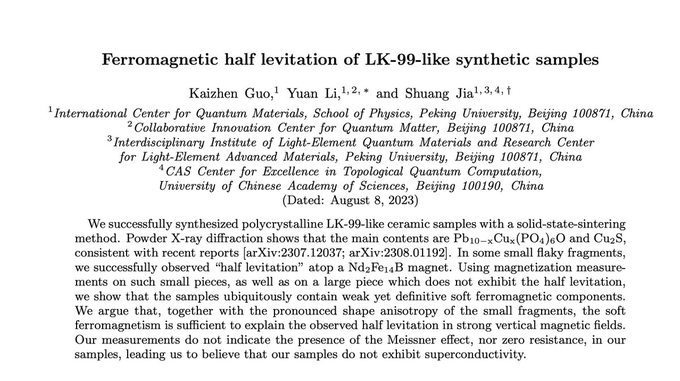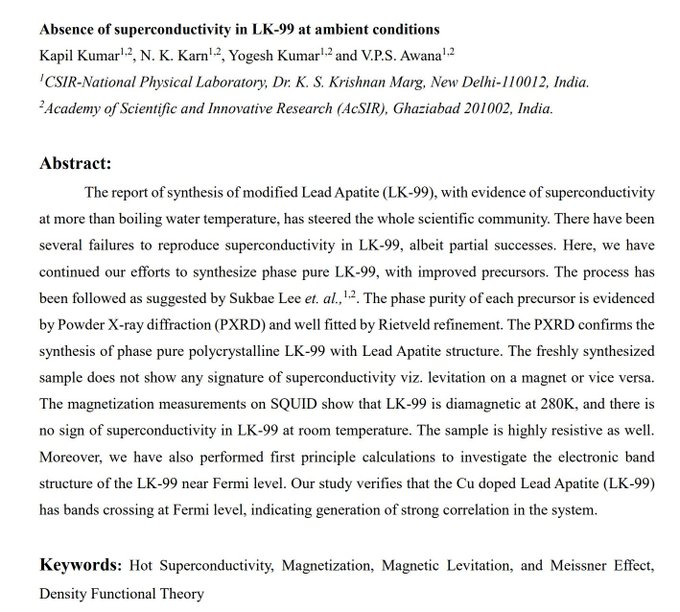Finally, the First Room-Temperature Superconductor
It conveys electricity in the climate of a crisp fall day, but only under pressures comparable to what you’d find closer to Earth’s core.
more…
Finally, the First Room-Temperature Superconductor
It conveys electricity in the climate of a crisp fall day, but only under pressures comparable to what you’d find closer to Earth’s core.
more…
And here’s the paper
https://www.nature.com/articles/s41586-020-2801-z
One of the long-standing challenges in experimental physics is the observation of room-temperature superconductivity1,2. Recently, high-temperature conventional superconductivity in hydrogen-rich materials has been reported in several systems under high pressure3,4,5. An important discovery leading to room-temperature superconductivity is the pressure-driven disproportionation of hydrogen sulfide (H2S) to H3S, with a confirmed transition temperature of 203 kelvin at 155 gigapascals3,6. Both H2S and CH4 readily mix with hydrogen to form guest–host structures at lower pressures7, and are of comparable size at 4 gigapascals. By introducing methane at low pressures into the H2S + H2 precursor mixture for H3S, molecular exchange is allowed within a large assemblage of van der Waals solids that are hydrogen-rich with H2 inclusions; these guest–host structures become the building blocks of superconducting compounds at extreme conditions. Here we report superconductivity in a photochemically transformed carbonaceous sulfur hydride system, starting from elemental precursors, with a maximum superconducting transition temperature of 287.7 ± 1.2 kelvin (about 15 degrees Celsius) achieved at 267 ± 10 gigapascals. The superconducting state is observed over a broad pressure range in the diamond anvil cell, from 140 to 275 gigapascals, with a sharp upturn in transition temperature above 220 gigapascals. Superconductivity is established by the observation of zero resistance, a magnetic susceptibility of up to 190 gigapascals, and reduction of the transition temperature under an external magnetic field of up to 9 tesla, with an upper critical magnetic field of about 62 tesla according to the Ginzburg–Landau model at zero temperature. The light, quantum nature of hydrogen limits the structural and stoichiometric determination of the system by X-ray scattering techniques, but Raman spectroscopy is used to probe the chemical and structural transformations before metallization. The introduction of chemical tuning within our ternary system could enable the preservation of the properties of room-temperature superconductivity at lower pressures
dv said:
And here’s the paperhttps://www.nature.com/articles/s41586-020-2801-z
One of the long-standing challenges in experimental physics is the observation of room-temperature superconductivity1,2. Recently, high-temperature conventional superconductivity in hydrogen-rich materials has been reported in several systems under high pressure3,4,5. An important discovery leading to room-temperature superconductivity is the pressure-driven disproportionation of hydrogen sulfide (H2S) to H3S, with a confirmed transition temperature of 203 kelvin at 155 gigapascals3,6. Both H2S and CH4 readily mix with hydrogen to form guest–host structures at lower pressures7, and are of comparable size at 4 gigapascals. By introducing methane at low pressures into the H2S + H2 precursor mixture for H3S, molecular exchange is allowed within a large assemblage of van der Waals solids that are hydrogen-rich with H2 inclusions; these guest–host structures become the building blocks of superconducting compounds at extreme conditions. Here we report superconductivity in a photochemically transformed carbonaceous sulfur hydride system, starting from elemental precursors, with a maximum superconducting transition temperature of 287.7 ± 1.2 kelvin (about 15 degrees Celsius) achieved at 267 ± 10 gigapascals. The superconducting state is observed over a broad pressure range in the diamond anvil cell, from 140 to 275 gigapascals, with a sharp upturn in transition temperature above 220 gigapascals. Superconductivity is established by the observation of zero resistance, a magnetic susceptibility of up to 190 gigapascals, and reduction of the transition temperature under an external magnetic field of up to 9 tesla, with an upper critical magnetic field of about 62 tesla according to the Ginzburg–Landau model at zero temperature. The light, quantum nature of hydrogen limits the structural and stoichiometric determination of the system by X-ray scattering techniques, but Raman spectroscopy is used to probe the chemical and structural transformations before metallization. The introduction of chemical tuning within our ternary system could enable the preservation of the properties of room-temperature superconductivity at lower pressures
> Recently, high-temperature conventional superconductivity in hydrogen-rich materials has been reported in several systems under high pressure
Yes.
So anyway thanks to dv we found any of these threads
https://tokyo3.org/forums/holiday/topics/5437/
https://tokyo3.org/forums/holiday/topics/11233/
https://tokyo3.org/forums/holiday/topics/14287/
might be suitable but we can’t remember where the recent drama played out.
Anyway, bloody ASIANS in CHINA and INDIA throw hot solvent on recent SLC superconductor claims.


https://arxiv.org/pdf/2308.03110.pdf
https://arxiv.org/ftp/arxiv/papers/2308/2308.03544.pdf
Even if LK-99 isn’t a room-temperature superconductor, “we’ll still learn something”
floating black square magnet above white box smoky
4 August 2023
By Evrim Yazgin
A Korean research team has made international headlines by claiming they have achieved world-first superconductivity at room temperature and ambient pressure.
Considered one of the holy grails of materials science, room-temperature superconductors could have a transformative impact by making power grids more efficient, helping develop renewable technologies, revolutionising electronics, providing a new platform for quantum computing, or even in engineering super-fast transportation.
Problems of extremes
Superconductors are special because they have little to no electrical resistance and they expel magnetic fields. Zero electrical resistance means superconductors have potential to transmit power without any loss. One remarkable effect of magnetic field expulsion in superconductors is that they levitate in the presence of a magnetic field.
But superconductivity has thus far only been seen under extreme conditions. Temperatures hundreds of degrees below zero and crushing pressures are required for superconductivity to be observed in a select few materials.
“High temperature” superconductors are those that exhibit superconductivity at temperatures higher than the boiling point of nitrogen (−196.2°C; 77 degrees above absolute zero).
The highest reliable temperature at which superconductivity has been observed is −135°C, seen in a class of compounds known as cuprates.
In 2020, US physicists believed they had developed a material that conducted electricity with zero resistance at 15°C, and at crushing pressures. But that claim later had to be retracted as further research raised doubts over its validity.
Scientists are always looking to engineer new materials that exhibit superconductivity at higher temperatures and lower pressures – thereby bypassing the inconvenient and costly apparatuses that prevent its widescale practical use.
The room-temperature superconductor is described in two papers which are yet to be peer reviewed, but are available on the preprint website arXiv.
Using a modified lead-apatite structure, referred to as LK-99, the authors claim the compound (Pb10−xCux(PO4)6O) exhibits zero electrical resistance “and the levitation phenomenon Meissner effect of a superconductor at room temperature and atmospheric pressure”.
Some scientists have raised doubts and suggested “fishy” and “sloppy” data supporting the bold claim.
According to Asia Financial, at least two of the co-authors have said the papers were published online without the consent of the researchers.
Dr Richard Taylor, principal research fellow in the Queensland University of Technology Faculty of Engineering, tells Cosmos that issues in scientific methods are not uncommon. He also notes that disagreements about when results are announced is “the undesirable normal behaviour of people in a hurry.”
“If you’ve got a chance of getting published first, it’s a big deal. I’m not trying to be derogatory, but it does put pressure on everybody to publish on the off chance that you’re right.
“The downside is if people say, ‘nice, but no cigar, it’s actually a semiconductor, it’s looking like a diamagnetic,’ you then have to come out and say, ‘oops, we made a mistake.’”
Is room-temperature superconductivity possible?
A Chinese experimental team released a video on social media which claims to reproduce the result of the Korean researchers, showing a tiny sample of LK-99 levitating.
“The Chinese group have said that LK-99 has some characteristics of superconductivity, but its material response to current flow looks more like a semiconductor rather than a superconductor,” says Taylor, “and what looks like a Meissner effect could be a diamagnetic response.”
“Theoretical physicists have hypothesised that there is really no high-end temperature limit on the appearance of superconductivity materials,” Taylor notes.
“We’ve all seen, not so much hoaxes, but just people getting a little bit enthusiastic about trying to define what superconductors are.”
Hot or not, the research may be valuable
Taylor remains optimistic that, whether or not the Korean researchers have achieved room-temperature superconductivity, it is worth keeping the conversation going.
“I think these announcements are really exciting. They are important to report, they’re important to keep in front of everybody. When I talk to industry about the potential of superconductivity, they ask ‘Well, can I have a bit?’ Well, maybe not today. But there’s potential.”
Taylor recommends allowing scientists around the world to test the claims before jumping to conclusions about their validity.
“Even if it’s a bit dodgy, we’ll still learn something,” Taylor notes. “That’s the point. We always learn something because we don’t fully understand superconductivity. When a new thing like this comes along, it helps a little.”
https://cosmosmagazine.com/technology/materials/lk-99-room-temperature-superconductor/